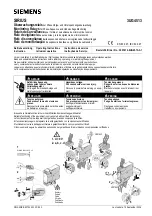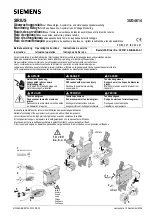
4. SETPOINT PROGRAMMING
OVERVIEW
4-1
4.1.1
TRIPS / ALARMS/ BLOCKS DEFINED
The SR469 Motor Management Relay has three basic categories of protection elements. They are TRIPS, ALARMS, and BLOCKS.
TRIPS
An SR469 trip feature may be assigned to any combination of the two Auxiliary relays, R2 and R3, in addition to the R1 Trip Relay. If a
Trip becomes active, the appropriate LED (indicator) on the SR469 faceplate will illuminate to show which of the output relays has oper-
ated. In addition to the Trip relay(s), a trip will always operate the Block Start relay. All trip features are latched. Once a relay has been
operated by a trip, the reset key must be pressed to reset that trip when the condition is no longer present. If there is a lockout time, the
Block Start relay will not reset until the lockout time has expired. Immediately prior to issuing a trip, the SR469 takes a snapshot of motor
parameters and stores them as pre-trip values which will allow for troubleshooting after the trip occurs. The cause of last trip message is
updated with the current trip and the SR469 display defaults to that message. All trip features are automatically logged and date and
time stamped as they occur. In addition, all trips are counted and logged as statistics such that any long term trends may be identified.
ALARMS
An SR469 alarm feature may be assigned to operate any combination of three output relays, R4 Alarm, R3 Auxiliary, and R2 Auxiliary.
When an Alarm becomes active, the appropriate LED (indicator) on the SR469 faceplate will illuminate when an output relay(s) has op-
erated. Each alarm feature may be programmed as latched or unlatched. Once a latched alarm feature becomes active, the reset key
must be pressed to reset that alarm. If the condition that has caused the alarm is still present (e.g. hot RTD) the Alarm relay(s) will not
reset until the condition is no longer present. If on the other hand, an unlatched alarm feature becomes active, that alarm will reset itself
(and associated output relay(s)) as soon as the condition that caused the alarm ceases. As soon as an alarm occurs, the alarms mes-
sages are updated to reflect the alarm and the SR469 display defaults to that message. Since it may not be desirable to log all alarms
as events, each alarm feature may be programmed to log as an event or not. If an alarm is programmed to log as an event, when it be-
comes active, it is automatically logged as a date and time stamped event
BLOCK START
An SR469 Block Start is a feature that prevents or inhibits the start of the motor based on some logic or algorithm. An SR469 Block Start
feature is always assigned to the Block Start relay. In addition to the Trip relay(s), a trip will always operate Block Start relay. If the con-
dition that has caused the trip is still present (e.g. hot RTD), or there is a lockout time when the Reset key is pressed, the Block Start
relay will not reset until the condition is no longer present or the lockout time has expired. All blocking features are always unlatched and
reset immediately when conditions that caused the block cease. In addition to becoming active in conjunction with trips, a block may
become active once the motor stops. There are several features that operate as such: Starts/Hour, Time Between Starts, Start Inhibit,
Restart Block, and SR469 Not Programmed. When a block becomes active, the block messages are updated to reflect the block
(complete with lockout time if required) and the screen defaults to that message. Blocks are normally not logged as events. If however, a
motor start or start attempt is detected when a block is active, it is automatically logged as a date and time stamped event. This scenario
might occur if someone shorts across the block terminals and overrides the SR469 protection to start the motor.
4. SETPOINT PROGRAMMING
4.1 OVERVIEW
Содержание SR469
Страница 7: ......
Страница 19: ...2 INSTALLATION MECHANICAL 2 5 2 1 5 TERMINAL LOCATIONS Figure 2 11 TERMINAL LAYOUT...
Страница 21: ...2 INSTALLATION ELECTRICAL 2 7 Figure 2 12 TYPICAL WIRING DIAGRAM...
Страница 32: ...ELECTRICAL 2 INSTALLATION 2 18 2 2 14 TYPICAL 2 SPEED MOTOR WIRING...
Страница 39: ...OVERVIEW 3 SR469 OPERATION 3 6 yy SETPOINTS yy S1 SR469 SETUP...
Страница 104: ...4 SETPOINT PROGRAMMING S11 MONITORING 4 65 Figure 4 24 TRIP COIL SUPERVISION...
Страница 113: ...S12 ANALOG I O 4 SETPOINT PROGRAMMING 4 74...
Страница 244: ...8 469PC PROGRAM WAVEFORM CAPTURE 8 13 Figure 8 11 WAVEFORM CAPTURE...
















































